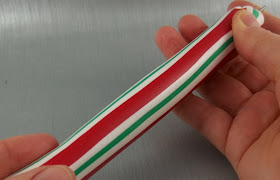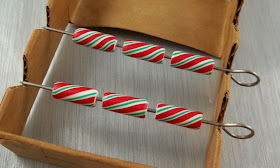Here is how you can make your own:
1. Make a "log" of white clay about the size of a large marshmallow and pierce it through the center with a steel mandrel or thin knitting needle.
2. Roll out some white, red and green clay (see color recipes below) on the 2nd or 3rd thickest setting of your pasta machine. Cut a length of each color slightly wider than the clay plug.
3. Cut strips from each of the colors and arrange them around your clay plug. I like to start with the red. I cut 4 strips at about 1/4" wide and arranged them equidistantly around the plug.
4. Fill in the gaps with narrower strips of green.
5. Fill in the final gaps with white. Roll a bit to smooth it out so there are no spaces between the colors.
6. Now roll out your clay plug by rolling it on the table and then lightly stretching it. Keep repeating this process until you have a nice long tube.
When it becomes too long for the mandrel, cut it in half and set one half aside.
At this point I like to trim each end off where you can see it is distorted but this is optional.
Keep the other half on the mandrel and continue rolling and stretching until it is the thickness you are happy with. At this point I like to twist it to give that nice candy cane swirl look.
Your beads are ready to bake, sand and finish. Make sure you "tent" your beads with some aluminum foil when baking to keep the clay as white as possible. You can also bake them in a pan filled with baking soda (be sure to cover the pan with foil during baking).
Tip: With some clays like Premo, the red tends to bleed into the white. I have found the white comes out much cleaner when working with Kato clay which is another plus. If it does "bleed" a bit, the white will generally come clean again after sanding.
Color Recipes: (Here are the ones I used but you can mix up your own)
Plug: Kato white
White: White Mix, Recipe # 1-2
Red: Tomato Puree, Recipe # 4-6 (increase the red to 5 parts)
Green: Christmas Green, Recipe # 7-5
** Above recipes found in my Clay Color System



































